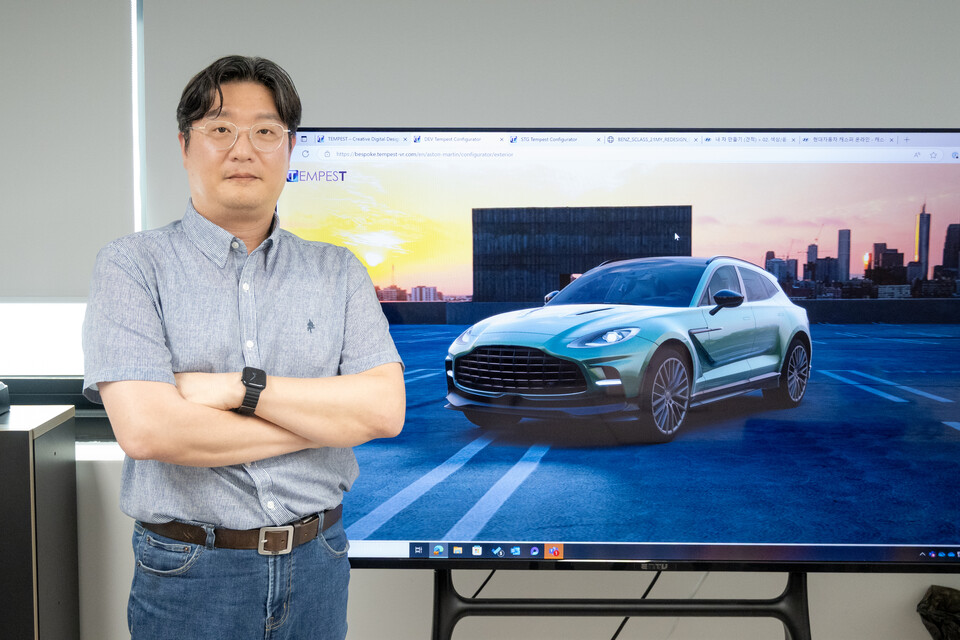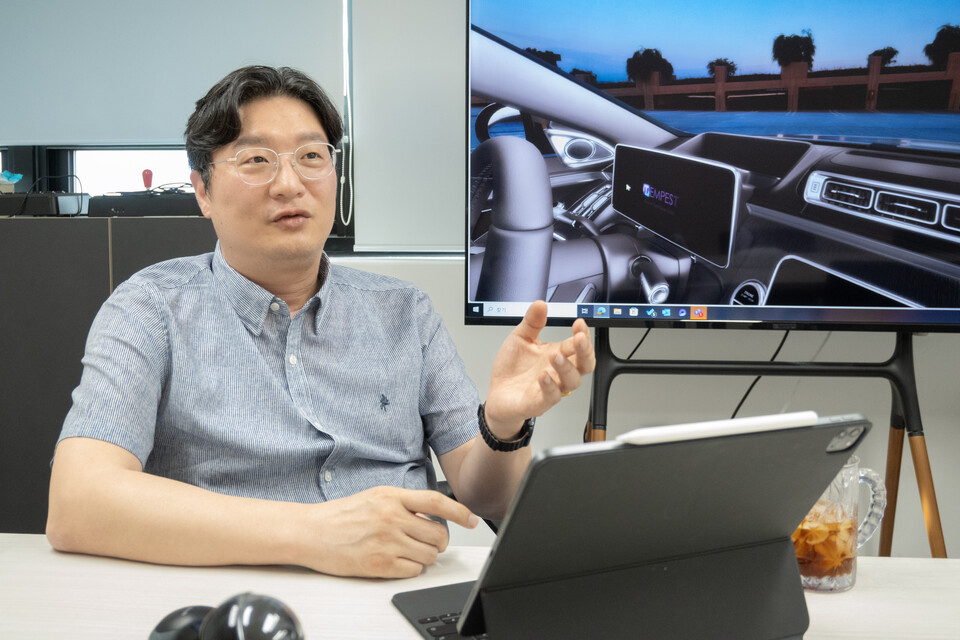
[Insight Korea – Reporter Dongsoo Kim]
In 2021, Hyundai Motor Company launched its compact SUV Casper exclusively through an online platform. From vehicle configuration to delivery, the entire process was conducted digitally. By April of last year, Casper had recorded cumulative sales of 120,000 units, becoming a successful case study in Korea’s growing trend of contactless, direct-to-consumer automotive sales.
Industry experts point to the “Build Your Car” feature as a key factor behind Casper’s online success. This service allows users to explore both the exterior and interior of the vehicle in full 360-degree view. Customers can change colors and options while inspecting every detail of the car, effectively overcoming the limitations of online-only sales where physical inspection isn’t possible.
On July 5, Insight Korea sat down with Soonyup Song, CEO of Tempest, the company behind the 3D configurator system that powers the “Build Your Car” experience. We discussed his entrepreneurial journey and vision for the future of digital vehicle customization.
Q: The term “3D configurator” may be unfamiliar to some. How would you explain it in simple terms?
Soonyup Song (CEO of Tempest):
“Simply put, a 3D configurator is a system that allows you to preview a product in 3D before purchasing it. Take building a custom PC, for example. A customer chooses components like the CPU and graphics card, but if the website only shows a list of options without a visual preview, it’s essentially just a quote. On the other hand, if the customer can actually see how the selected parts come together, that’s what we call a 3D configurator.
A great example is Hyundai’s Casper ‘Build Your Car’ service. When buying a car, customers select options like color and trim. Traditionally, the visuals would change slightly depending on the options, but with a 3D configurator, the system generates a realistic 3D model of the vehicle. Customers can rotate and inspect the car from every angle, both inside and out, making it much easier to make informed decisions online.”
Q: What are the key advantages of your service for customers?
Soonyup Song (CEO of Tempest):
“For customers, it can be frustrating when manufacturers only provide static images that show what they want you to see. Even in physical showrooms, it’s often impossible to preview how selected options will look on the actual product. In most cases, you’re left relying on catalog photos.
With our 3D configurator-powered ‘Build Your Car’ service, customers receive far more accurate and interactive information. They can view the vehicle in a fully rotatable 360-degree environment and see exactly how each option—whether exterior color, interior trim, or accessories—affects the final look of the car. It’s a much more immersive and informed experience.”
Q: Tempest has worked with several automotive companies. Can you share another example of collaboration?
Soonyup Song (CEO of Tempest):
“I used to work with an agency affiliated with Kia. At the time, Kia approached us with a proposal to create 3D images of their vehicles for catalog production. In 2012, when the K9 was launched, I worked on a 3D rendering project that was later used in the official vehicle catalog. After that experience, I founded Tempest in 2013 and continued to contribute to Kia’s catalog production through our own company.”
Q: Was catalog production the main focus during Tempest’s early days?
Soonyup Song (CEO of Tempest):
“At the time, catalog production was the only thing we could realistically pursue. The environment wasn’t ideal, so we had to explore other possibilities. Back then, Tempest was focused solely on design work, and I quickly realized the limitations of that approach. I felt the need to integrate development and IT, so I brought in developers and started working on various projects—including iPhone app development, which was trending at the time.
Through those experiences, we gradually evolved and eventually built the foundation for what Tempest is today—a company equipped with a full-fledged 3D configurator system.”
Q: It must have been challenging in the early days of the business.
Soonyup Song (CEO of Tempest):
“Absolutely. When I was working on the Genesis project, I didn’t have any employees, so I had to do everything on my own. There were times when I slept only two hours a day for an entire month. That period was definitely the most difficult. But as the business began to stabilize, I was able to start hiring staff, and by around 2018, our team had grown to 11 people.”

Q: Many of your projects are related to the automotive industry. Can you tell us more about your career background?
Soonyup Song (CEO of Tempest):
“I majored in journalism and mass communication in college. After graduation, I taught myself animation and began my career at a game company. Over time, I became more interested in the design field and started considering studying abroad. During my undergraduate years, I often collaborated with designers while working on advertising projects. Watching them bring ideas to life through design made me want to try it myself. I realized that if I could directly visualize my own ideas, it could be even more effective.
That led me to pursue a graduate degree in design. After completing my studies, I also taught at a university for a while.”
Q: If Hyundai Motor is using your technology, it must offer something truly unique. What sets Tempest apart?
Soonyup Song (CEO of Tempest):
“One of the biggest strengths of Tempest’s 3D configurator system is its lightweight architecture. The file sizes are extremely small, yet the image quality remains high—even when displayed on large screens, the visuals stay sharp and clear. This lightweight nature also brings another major advantage: the system works just as smoothly on mobile devices as it does on PCs.
Thanks to this technology, we were able to secure a patent related to data optimization. Even if other companies offer similar services, it’s very difficult for them to match the performance and flexibility of our solution.”
Q: While automotive projects seem to be your main focus, are there other industries you’re exploring?
Soonyup Song (CEO of Tempest):
“Yes, automotive projects are definitely our core business. However, we’ve recently started expanding into other areas such as footwear and fashion accessories. You could call it revenue diversification, but more accurately, it’s a strategic move to broaden our market reach. I believe that for Tempest to grow, the market for 3D configurator systems itself needs to expand. That’s why we’re actively exploring opportunities in various industries.”
Q: What are your goals for the future of Tempest?
Soonyup Song (CEO of Tempest):
“My goal is to turn the name ‘Tempest’ into a recognizable brand. For example, when people think of facial tissues, they often say ‘Kleenex,’ or when they think of bleach, they say ‘OxiClean.’ I know it’s the dream of many entrepreneurs, but I hope that when people think of customization or personalization services, the name ‘Tempest’ naturally comes to mind.”
출처 : 인사이트코리아(https://www.insightkorea.co.kr)
원문: 원문읽기